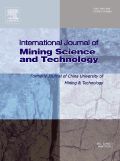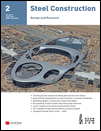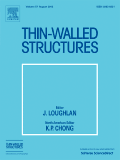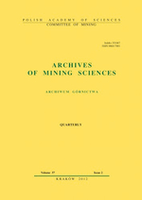
Underground Space
Scope & Guideline
Advancing Knowledge Beneath the Surface
Introduction
Aims and Scopes
- Geotechnical Engineering and Mechanics:
Research on the mechanical behavior of soil and rock in underground settings, including stability analysis, ground movement prediction, and the interaction of underground structures with surrounding geotechnical conditions. - Tunneling Technologies and Methodologies:
Development and optimization of tunneling methods, such as shield tunneling and NATM (New Austrian Tunneling Method), focusing on performance prediction, operational efficiency, and safety measures. - Underground Space Utilization:
Studies on the planning, design, and sustainability of urban underground spaces, addressing issues related to urban resilience, environmental impact, and innovative uses of subterranean environments. - Seismic and Vibration Analysis:
Investigations into the seismic performance of underground structures and the effects of vibrations from surface activities, including monitoring techniques and mitigation strategies. - Machine Learning and Data-Driven Approaches:
Application of advanced computational methods, including machine learning and deep learning, to predict and analyze underground behaviors, improve design efficiency, and enhance decision-making processes in underground engineering.
Trending and Emerging
- Integration of AI and Machine Learning:
The application of artificial intelligence and machine learning techniques is on the rise, enhancing predictive modeling, risk assessment, and optimization in tunneling and underground construction. - Sustainability and Environmental Impact:
A growing focus on sustainability in underground construction practices, including studies on minimizing environmental impacts, optimizing resource use, and integrating renewable energy systems into underground spaces. - Smart Monitoring and Real-Time Data Utilization:
Emerging technologies for real-time monitoring of underground environments, utilizing IoT (Internet of Things) and data analytics to improve safety and operational efficiency. - Advanced Materials and Construction Techniques:
Research into new materials and construction methods, such as fiber-reinforced composites and smart materials, which enhance the durability and performance of underground structures. - Resilience and Adaptation in Urban Planning:
An increased emphasis on the role of underground spaces in enhancing urban resilience, particularly in response to climate change and urbanization challenges, reflecting a broader trend in urban planning.
Declining or Waning
- Traditional Methods of Ground Investigation:
There has been a noticeable reduction in studies focusing solely on conventional ground investigation techniques (e.g., borehole surveys), as researchers increasingly adopt advanced technologies and data-driven approaches. - Static Structural Analysis Methods:
The reliance on traditional static analysis methods for assessing underground structures is waning, with a growing preference for dynamic analysis and real-time monitoring techniques that account for changing conditions. - Single-Dimensional Modeling Approaches:
Research employing single-dimensional models for complex underground behavior is becoming less common, with a shift towards multi-dimensional and integrated modeling techniques that better capture the realities of underground environments. - Historical Case Studies:
While case studies remain important, there has been a decline in the publication of historical case studies in favor of new methodologies, innovative technologies, and contemporary issues that impact current underground practices.
Similar Journals

International Journal of Mining Science and Technology
Advancing Sustainable Solutions for Tomorrow's Mining ChallengesThe International Journal of Mining Science and Technology, published by ELSEVIER, is a premier open access journal that has been at the forefront of disseminating groundbreaking research in the fields of mining science, geotechnical engineering, and environmental sustainability since its inception in 2012. With a commendable impact factor and distinguished quartile rankings—including Q1 status in Energy Engineering, Geochemistry and Petrology, and Geotechnical Engineering—this journal stands as a vital resource for researchers, professionals, and students alike. The journal's commitment to open access since 2017 ensures that the latest advancements in mining techniques, energy solutions, and geological innovations are readily available to the global research community. With consistently high rankings in Scopus and a strong percentile performance, the International Journal of Mining Science and Technology plays a crucial role in shaping the future of mining and earth sciences, making it a must-read for anyone involved in these dynamic fields.

Steel Construction-Design and Research
Innovating Design in Steel Construction ResearchSteel Construction-Design and Research is a premier journal published by ERNST & SOHN, focusing on the latest advancements and research within the field of steel construction and structural engineering. With an ISSN of 1867-0520 and E-ISSN 1867-0539, this journal serves as a vital resource for engineers, researchers, and academics committed to enhancing the design and performance of steel structures. Located in the United States, its reputation is bolstered by its impressive standing in various Scopus categories; it ranks in the Q2 quartile for Building and Construction, Civil and Structural Engineering, Mechanics of Materials, and Metals and Alloys as of 2023. This journal is particularly significant as it captures high-quality research spanning critical years from 2011 to 2012 and 2014 to 2024, fetching valuable insights into the evolving methodologies and applications in steel construction. Although it does not operate under an Open Access model, its rigorous peer-review process ensures that contributors deliver top-tier research, making it an essential publication for anyone engaged in the field.

JOURNAL OF MINING SCIENCE
Advancing Knowledge in Mining and Earth SciencesJOURNAL OF MINING SCIENCE, published by PLEIADES PUBLISHING INC, is a leading platform for research and development in the fields of geology, geotechnical engineering, and engineering geology. With an ISSN of 1062-7391 and E-ISSN of 1573-8736, this journal has established itself as a notable contributor to the mining and earth sciences communities since its inception in 1991. The journal is indexed in prestigious databases and currently holds a Q3 ranking in both geology and geotechnical engineering categories, recognizing the impact and quality of the research it publishes. Although it does not offer open access, it provides extensive insights from cutting-edge studies that appeal to researchers, professionals, and students alike. The Journal of Mining Science aims to disseminate significant advancements in mining technology and its environmental implications, promoting sustainability and innovation within the industry. With its comprehensive scope and commitment to excellence, this journal serves as an invaluable resource for stakeholders in academia and industry striving to enhance their knowledge and practices in mining science.

THIN-WALLED STRUCTURES
Pioneering Research in Building and ConstructionTHIN-WALLED STRUCTURES is a premier international journal published by Elsevier Science Ltd, focusing on the critical areas of Building and Construction, Civil and Structural Engineering, and Mechanical Engineering. With an impressive impact factor and categorization in the Q1 quartile of each respective field, this journal stands at the forefront of engineering research, boasting commendable Scopus rankings—52nd for Mechanical Engineering, 18th for Building and Construction, and 32nd for Civil and Structural Engineering. Since its inception in 1983, THIN-WALLED STRUCTURES has provided a vital platform for disseminating innovative research, practical applications, and theoretical advancements in thin-walled structures, encouraging the development of safer and more efficient design methodologies. Although it operates on a traditional access model, the journal is committed to maintaining high-quality peer review and publishing, making it an essential resource for researchers, professionals, and students aiming to contribute to and benefit from the latest advancements in this dynamic field.

Journal of Bridge Engineering
Advancing the Future of Bridge EngineeringThe Journal of Bridge Engineering, published by the ASCE - American Society of Civil Engineers, is a premier academic journal dedicated to the specialized field of bridge engineering and structural design. With a strong commitment to advancing knowledge from 1996 to 2024, this journal is recognized for its excellence, holding a prestigious Q1 ranking in both the Building and Construction and Civil and Structural Engineering categories according to the latest 2023 metrics. The journal's ISSN 1084-0702 and E-ISSN 1943-5592 signify its commitment to scholarly communication in a digital age. While it does not currently follow an open access model, the Journal of Bridge Engineering significantly impacts the engineering community, appealing to researchers, professionals, and students who seek cutting-edge research and innovative practices in bridge engineering. Its current rankings on Scopus place it among the top journals in its field, reinforcing its role as a critical resource for advancing the state of the art in bridge design, maintenance, and sustainability.

International Journal of Physical Modelling in Geotechnics
Transforming research into practical geotechnical applications.The International Journal of Physical Modelling in Geotechnics, published by Emerald Group Publishing Ltd, is a leading platform dedicated to advancing the field of geotechnical engineering and engineering geology. With a focus on the practical applications of physical modeling, this journal contributes significantly to the understanding of soil and rock behavior under various conditions, making it invaluable for researchers, professionals, and students alike. Heightened by its Q2 ranking in its category and a notable 61st percentile ranking among its peers, this journal has established itself as a credible source of knowledge and innovation within the academic community. Although it does not currently offer open access, its rigorous peer-review standards ensure the dissemination of high-quality research and insights. The journal, covering a timeline of topics from 2011 to 2024, aims to bridge the gap between theory and practice, ultimately fostering advancements in geotechnical solutions necessary for infrastructure development. To stay at the forefront of geotechnical research, contributing authors and engaged readers are encouraged to explore and participate in this dynamic academic discussion.

Jordan Journal of Civil Engineering
Connecting Theory and Practice in Civil EngineeringThe Jordan Journal of Civil Engineering, ISSN 1993-0461 and E-ISSN 2225-157X, serves as a pivotal platform for research dissemination in the field of civil engineering. Published by Jordan University of Science & Technology, this journal has established itself as a vital resource since its inception in 2007 and continues to impact the academic community with its wide-ranging scope covering innovative practices and cutting-edge research in civil and structural engineering. Holding a respectable Q3 ranking in the 2023 category, with Scopus positioning it at rank #235 out of 379, the journal reflects growing recognition within its discipline. Although currently not an open-access publication, it provides essential insights that can benefit researchers, industry professionals, and students seeking to contribute to advancements in civil engineering through rigorous scholarly articles and studies up to 2024. Its commitment to high academic standards enhances the relevance and importance of its contributions to both local and global engineering practices.

EARTHQUAKE SPECTRA
Leading the charge in earthquake resilience and engineering.EARTHQUAKE SPECTRA, published by SAGE PUBLICATIONS INC, is a premier journal dedicated to the field of geophysics, geotechnical engineering, and engineering geology, with a specific focus on seismic phenomena. Issued both in print (ISSN: 8755-2930) and electronically (E-ISSN: 1944-8201), the journal has maintained its position as a leading source of high-quality research since its inception in 1984. Recognized in the 2023 Category Quartiles as Q1 in both geophysics and geotechnical engineering, it is highly regarded in the academic community, ranking 11 out of 165 in its field, placing it in the 93rd percentile of Earth and Planetary Sciences, and 30 out of 229 for geotechnical engineering with an 87th percentile standing. With a commitment to advancing knowledge and practice in earthquake engineering, EARTHQUAKE SPECTRA publishes original research, case studies, and critical reviews that inform the design and construction practices related to seismic events. Although it does not currently offer open access, the journal's impact on the discipline remains significant, making it an essential resource for researchers, professionals, and students dedicated to understanding and mitigating the effects of earthquakes.

CANADIAN GEOTECHNICAL JOURNAL
Uncovering Insights in Soil Mechanics and Engineering PracticesCanadian Geotechnical Journal, published by Canadian Science Publishing, stands as a premier resource in the field of geotechnical engineering, focusing on the science and practice of soil mechanics, engineering geology, and related disciplines. Established in 1968, this esteemed journal has earned a distinguished reputation, holding a Q1 ranking in both Civil and Structural Engineering as well as Geotechnical Engineering and Engineering Geology as of 2023. It features a rigorous peer-review process that ensures the publication of high-quality research, making it essential reading for researchers, professionals, and students alike. With an impressive Scopus rank of #63 out of 379 in Civil and Structural Engineering and #41 out of 229 in Geotechnical Engineering, the journal continues to contribute significantly to the advancement of knowledge in geotechnics. While the journal does not currently provide open access options, it remains a vital platform for disseminating innovative findings and fostering academic collaboration in the geotechnical community.

Archives of Mining Sciences
Exploring the depths of geochemical innovation.Archives of Mining Sciences is a peer-reviewed journal published by the Polska Akademia Nauk (Polish Academy of Sciences), dedicated to advancing knowledge in the fields of geochemistry, petrology, geotechnical engineering, and engineering geology. With an ISSN of 0860-7001 and an E-ISSN of 1689-0469, this journal has been a vital resource for professionals and researchers since its inception in 1991. Housed in Poland, the journal serves as a platform for the dissemination of significant research results, technical developments, and case studies, ensuring accessibility to a global audience. Competing in a rigorous landscape, it has achieved a notable Q3 ranking in 2023 within both the Geochemistry and Petrology and Geotechnical Engineering and Engineering Geology categories. As it converges through its years of publication—currently covering the period from 2008 to 2024—the journal maintains a strong focus on fostering innovative research that addresses crucial geological challenges. Its presence in Scopus rankings reinforces its commitment to quality and relevance, making it an essential read for students and professionals seeking to stay at the forefront of mining sciences.